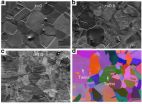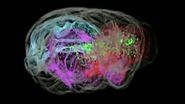(Press-News.org) (Lebanon, 04/08/2014)— Binge drinking by teenagers and young adults is strongly associated with liking, owning, and correctly identifying music that references alcohol by brand name according to a study by the University of Pittsburgh and Dartmouth-Hitchcock Norris Cotton Cancer Center.
These findings, based on a national randomized survey of more than 2,500 people ages 15 to 23, suggests that policy and educational interventions designed to limit the influence of alcohol brand references in popular music could be important in reducing alcohol consumption in teens and young adults. The results are published online in the journal Alcoholism: Clinical & Experimental Research.
"Brand references may serve as advertising, even if they are not paid for by the industry," said senior author James D. Sargent, MD, co-director of the Cancer Control Research Program at Norris Cotton Cancer Center and professor of pediatrics in the Geisel School of Medicine at Dartmouth.
Alcohol is considered the third leading lifestyle-related cause of death in the U.S. according to the Centers for Disease Control and Prevention.
Of the 2,541 participants who completed the survey, 1,488, or 59 percent, reported having had a complete alcoholic drink, defined as 12 ounces of beer, 5 ounces of wine or 1.5 ounces of hard liquor. Of those, 18 percent reported binging – or drinking heavily over a short period of time – at least monthly and 37 percent reported having had problems, such as injuries, due to alcohol.
"Every year, the average adolescent is exposed to about 3,000 references to alcohol brands while listening to music," said lead author Brian A. Primack, MD, PhD, associate professor of medicine and pediatrics and director of the Program for Research on Media and Health, University of Pittsburgh School of Medicine. "It is important that we understand the impact of these references to alcohol brands in an age group that can be negatively impacted by alcohol consumption."
In the survey, which could be completed either through the Internet or on paper, participants were given the titles of popular songs with alcohol mentions and asked if they liked the song or owned the song. They were also tested to determine if they could spontaneously recall what brand of alcohol was mentioned in the song.
Survey participants who could correctly recall alcohol brands in songs had more than twice the odds of having had a complete alcoholic drink, compared to those who could not recall the alcohol brand, even after adjusting for factors including age, socioeconomic status, and alcohol use by a parent or friend. The participants who could identify the alcohol brands in songs also had greater odds of binge alcohol use.
"A surprising result of our analysis was that the association between recalling alcohol brands in popular music and alcohol drinking in adolescents was as strong as the influence of parental and peer drinking, and an adolescent's tendency toward sensation-seeking," said Primack. "This may illustrate the value that this age group places in the perceived opinions and actions of music stars."
The authors suggest that one possible solution could be to empower adolescents with critical thinking skills. "Media literacy is a growing educational methodology that may be successful in helping young people make healthier decisions," Pimrack said. "In the case of alcohol, it may be valuable to help them understand how alcohol brand references in music may manipulate their thoughts and emotions to sell them a product."
INFORMATION:
About Norris Cotton Cancer Center at Dartmouth-Hitchcock
Norris Cotton Cancer Center combines advanced cancer research at Dartmouth and the Geisel School of Medicine with patient-centered cancer care provided at Dartmouth-Hitchcock Medical Center, at Dartmouth-Hitchcock regional locations in Manchester, Nashua, and Keene, NH, and St. Johnsbury, VT, and at 12 partner hospitals throughout New Hampshire and Vermont. It is one of 41 centers nationwide to earn the National Cancer Institute's "Comprehensive Cancer Center" designation. Learn more about Norris Cotton Cancer Center research, programs, and clinical trials online at cancer.dartmouth.edu.
National survey links teen binge drinking and alcohol brand references in pop music
2014-04-08
ELSE PRESS RELEASES FROM THIS DATE:
Searching high and low for dark matter
2014-04-08
Recently, dark matter hunters from around the world gathered at the University of California, Los Angeles for "Dark Matter 2014." The annual conference is one of the largest of its kind aimed at discussing the latest progress in the quest to identify dark matter, the unknown stuff that makes up more than a quarter of the universe yet remains a mystery.
So where does the hunt stand? Between sessions, three leading physicists at the conference spent an hour discussing the search for dark matter on several fronts.
"This conference has highlighted the progression of larger ...
The long reach of Alzheimer's
2014-04-08
LEBANON, NH – To address the burgeoning demands of Alzheimer's disease that will affect generations, new policies will have to be adopted to acknowledge the complex and unique needs of people with dementia.
The aging of the U.S. population has turned the prism to focus on the increasing number of families facing the challenge of providing care for people with dementia, said Julie P.W. Bynum, associate professor at The Dartmouth Institute for Health Policy & Clinical Practice. Writing in the April issue of Health Affairs, she says the "long reach" of Alzheimer's will ...
Experimental drug shows promise for treatment-resistant leukemias
2014-04-08
Research in mice and human cell lines has identified an experimental compound dubbed TTT-3002 as potentially one of the most potent drugs available to block genetic mutations in cancer cells blamed for some forms of treatment-resistant leukemia.
Results of the research by Johns Hopkins Kimmel Cancer Center investigators, described March 6 in the journal Blood, show that two doses a day of TTT-3002 eliminated leukemia cells in a group of mice within 10 days. The treatment performed as well as or better than similar drugs in head-to-head comparisons.
More than 35 percent ...
Location matters when it comes to deal-making, says new study
2014-04-08
Toronto – Even six-year-olds know who you sit beside matters, whether you're in first grade or at a high-powered dinner.
But now a new study, using the U.S. Senate Chamber as its laboratory, provides documented evidence of that phenomenon. It shows that where a person is located influences who they interact with and who they will turn to in order to build support for their own agenda.
For the powerful however, seating arrangements don't make much of a difference. That's because the people they need support from usually come to them.
The study's researchers chose ...
A new twist makes for better steel, researchers find
2014-04-08
PROVIDENCE, R.I. [Brown University] — Researchers from Brown University and universities in China have found a simple technique that can strengthen steel without sacrificing ductility. The new technique, described in Nature Communications, could produce steel that performs better in a number of structural applications.
Strength and ductility are both crucial material properties, especially in materials used in structural applications. Strength is a measure of how much force is required to cause a material to bend or deform. Ductility is a measure of how much a material ...
NASA's Aqua satellite reveals Tropical Cyclone Ita strengthening
2014-04-08
Tropical Cyclone Ita's maximum sustained winds have increased over the last day and NASA's Aqua satellite provided forecasters at the Joint Typhoon Warning Center with a visible look at the storm on April 8.
NASA's Aqua satellite passed over Ita at 3:30 UTC/11:30 p.m. EDT on April 7, and the Moderate Resolution Imaging Spectroradiometer provided a visible image of Tropical Cyclone Ita. The MODIS image showed a large area of strong thunderstorms south and northeast of the center of circulation. At the same time, the Atmospheric Infrared Sounder or AIRS instrument aboard ...
Scientists reveal potential link between brain development and breast cancer gene
2014-04-08
VIDEO:
Scientists at the Salk Institute have uncovered details into a surprising -- and crucial -- link between brain development and BCRA1, a gene whose mutation is tied to breast and ovarian cancer.
Click here for more information.
LA JOLLA—Scientists at the Salk Institute have uncovered details into a surprising—and crucial—link between brain development and a gene whose mutation is tied to breast and ovarian cancer. Aside from better understanding neurological damage associated ...
Why binge drinkers are slower to heal from their wounds
2014-04-08
MAYWOOD, Ill. – People who are injured while binge drinking are much slower to heal from wounds suffered in car accidents, shootings, fires, etc.
Now a new study is providing insights into why alcohol has such a negative effect on wound healing. Loyola University Chicago Stritch School of Medicine researchers report that binge alcohol exposure significantly reduced levels of key components of the immune system involved in healing.
The study by senior author Katherine A. Radek, PhD, and colleagues from Loyola's Alcohol Research Program and the Infectious Disease and ...
Global health funding reaches new high as funding priorities shift
2014-04-08
Washington, D.C.—Global health funding hit an all-time high of $31.3 billion in 2013, five times greater than in 1990. Yet with 3.9% growth from 2012 to 2013, the year-over-year increase falls short of the rapid rates seen over the previous decade, according to new research by the Institute for Health Metrics and Evaluation (IHME) at the University of Washington being published online in a web first edition on April 8 by Health Affairs.
As funding from many bilateral donors and development banks has declined, growth in funding from the GAVI Alliance, the Global Fund ...
UNC researchers find genetic trigger for RSV-induced infant hospitalizations
2014-04-08
April 8, 2014 CHAPEL HILL, N.C. – Researchers at UNC School of Medicine have pinpointed a viral protein that plays a major role in making respiratory syncytial virus (RSV) the most common cause of hospitalization in children under one year of age.
The discovery, published April 8 in the Journal of Clinical Investigation, is the first step toward identifying better diagnostics and potential treatments for an infection that strikes nearly all children before they reach the age of three and causing severe disease in 3 percent of infected children. RSV infection leads to ...




